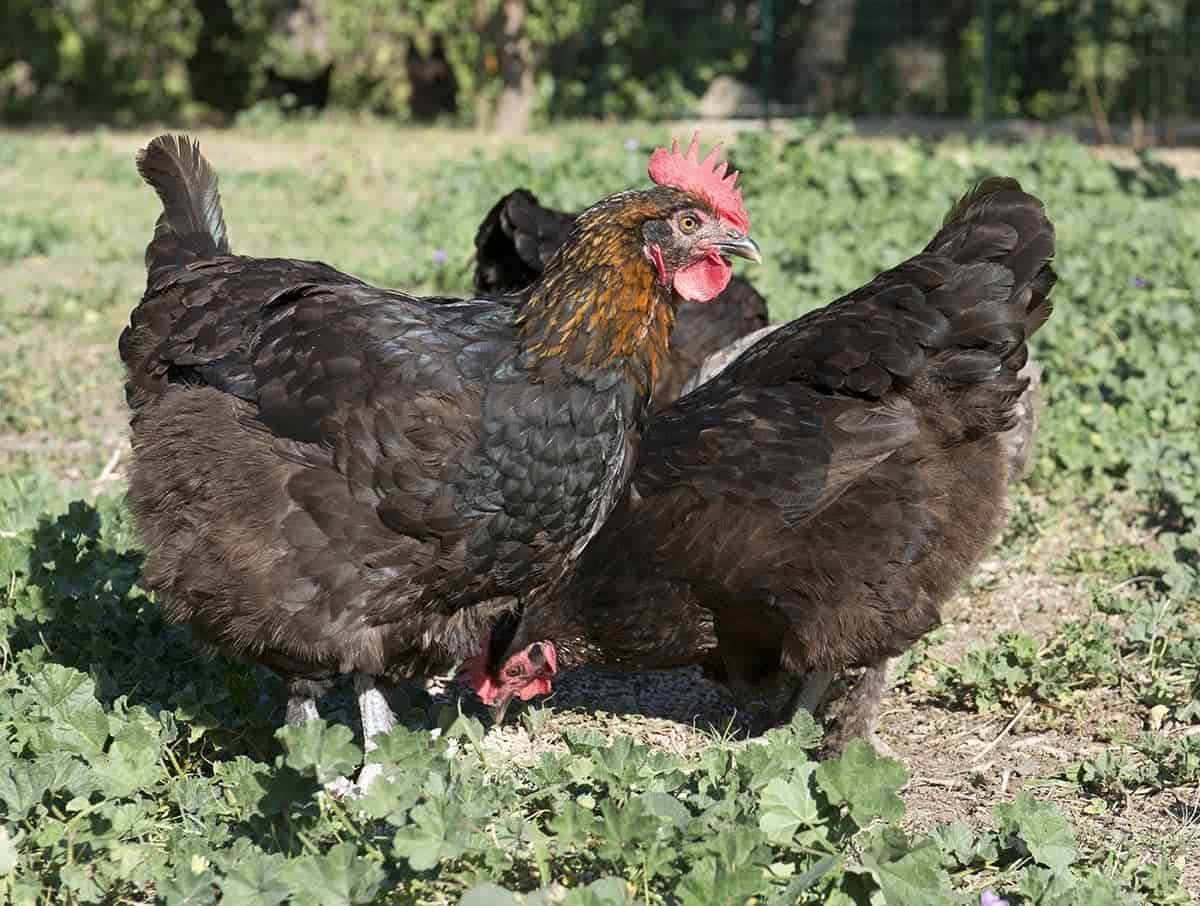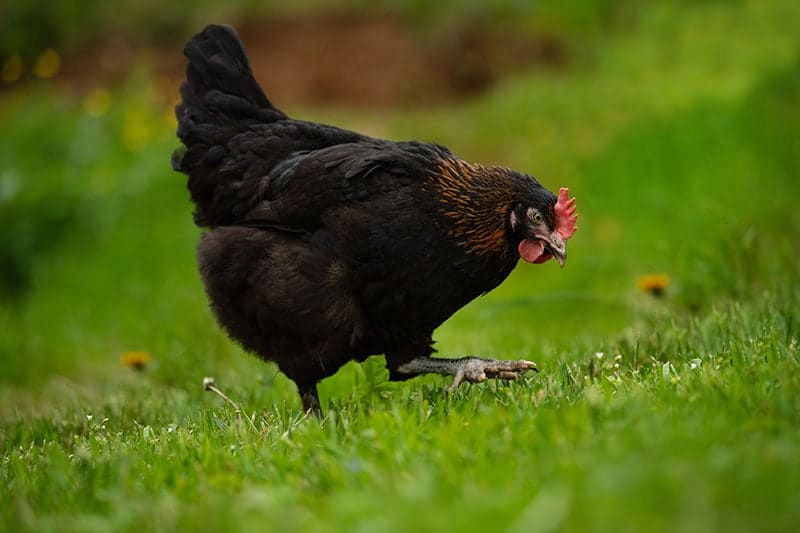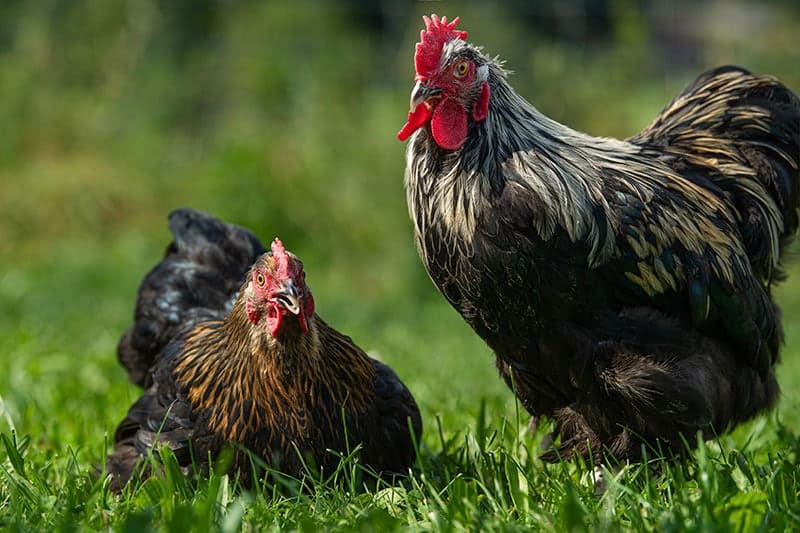Marans chickens are highly sought after because of their dark colored eggs. Before reaching for one of these rare chicken breeds, however, there are a few things you need to know. For example, you aren’t guaranteed dark brown eggs, though it is a possibility.
In this guide, we give you all the crucial information you need to know before buying Marans chickens. Let’s get started and learn about these unique feathered friends.

Quick Facts About Marans Chickens
| Species Name: | Marans or Poule de Marans |
| Family: | Phasianidae |
| Care Level: | Beginner |
| Temperature: | Prefers mild, but hardy in most environments |
| Temperament: | Calm, friendly, and quiet |
| Color Form: | Variety |
| Lifespan: | 8 years |
| Size: | 8 lbs. |
| Diet: | Chicken feed and water |
| Minimum Coop Size: | 4 sq. ft. per adult |
| Coop Set-Up: | Coop with roosting perch and nesting boxes |
| Compatibility: | Compatible with other chickens and animals |
Marans Chicken Overview
Marans chickens are a popularly known chicken breed for producing dark brown eggs. They are named after Marans, a city in France. Because of this French origin, you actually do not pronounce the “S” at the end of the word “Marans,” and the “S” is present whether you are referring to one chicken or many.
It is unclear exactly which birds were used in the breeding of the Marans chicken. We do know that Marans were developed in the late 1800s. A number of bird breeds, including game type birds, were used. Experts agree that Langshans were used and maybe Faverolles.
The early breeders were trying to create a chicken that would produce dark brown eggs. They weren’t particularly interested in appearance, resulting in multiple types of Marans. Marans with feathers on its legs and feet are called French Marans, whereas chickens without feathers in these locations are English Marans.
Because of the additional feathering on the legs and feet, this breed requires a little bit more care and maintenance than other chickens. Luckily, they are relatively friendly, making maintenance a bit more enjoyable.
Even though these chickens are most known for their dark brown eggs, not all Marans produce the deep chocolate color they are known for. In fact, most do not lay dark eggs. Instead, the majority of hens lay brown eggs, but not dark brown eggs. Plus, hens lay lighter eggs the older they get.
Marans are a great dual-purpose bird. They produce hardy meat and lay quite a few eggs. This makes them a great addition to many farms. At the same time, they have a unique and attractive look.

How Much Do Marans Chickens Cost?
Because Marans are a rare breed, they are more expensive than other chickens. More so, their price ranges dramatically based on egg color, egg quality, and breeding heritage.
When you first start purchasing Marans for hatching eggs, they will cost at least $3. Hatchery-quality chicks will cost around $5.50 while point of lay hens can cost as much as $70. If you are looking for a chicken that can lay dark brown eggs, you can expect that individual to cost twice as much as other Marans.

Typical Behavior & Temperament
Marans are known as a fast-growing breed. They are hardy and will thrive in most climates, including cold and warm climates, though they prefer cooler or milder temperatures. They also are resistant to a lot of diseases and are considered really tough.
Despite their tough nature, they are generally docile. In fact, neither males nor females tend to be aggressive, which is unique for roosters. They thrive best in a free-range environment because they can get lazy whenever raised in confinement. Even though they have the potential to get lazy, they are better in confinement than other chickens.
The hens tend to be really great mothers who go broody. Nevertheless, one Marans hen will produce 150 to 200 eggs a year, which is quite a bit for a broody breed.

Appearance & Varieties
Even though Marans were not bred for appearances, they are considered an attractive breed. They are known for having a tight feathering, which is typically found on gamebirds. Tight feathering includes short, narrow, and rigid feathers, lacking much fluff.
Additionally, Marans have medium to large sized single combs. Typically, these combs will stand upright, but some females have combs that flop partially to the side. These chickens also have red earlobes and medium sized wattles.
As we already mentioned, the French Marans will have feathering on their legs. This feathering will be thin. English Marans, on the other hand, have bare legs. Feathering is required of show birds.
Today, there are numerous types of Marans, but most are not recognized by the APA. The most popular Marans varieties in the states include the Black Copper Marans and Cuckoo Marans.
- Birchen (not recognized by the APA)
- Black
- Black Copper
- Black-Tailed Buff (not recognized by the APA)
- Blue (not recognized by the APA)
- Blue Copper (not recognized by the APA)
- Blue Wheaten (not recognized by the APA)
- Brown Red (not recognized by the APA)
- Columbian (not recognized by the APA)
- Golden Cuckoo (not recognized by the APA)
- Salmon (not recognized by the APA)
- Silver Cuckoo (not recognized by the APA)
- Wheaten
- White
Because there are so many different types of Marans, the chicks come in different shades and patterns too. It is incredibly difficult to sex Marans chicks, meaning that you may get a rooster when you wanted a hen.


How to Take Care of Marans Chickens
Marans are considered a hardy bird breed, but they have special needs you must keep in mind. Most importantly, Marans are large birds. Their coops need to be big enough to accommodate their bustier build.
Habitat, Coop Conditions & Setup
Coop
You must provide any chicken breed with a coop so that they can remain safe from the weather and predators. Marans need a coop that can accommodate their larger size. At least 4 sq. ft. is required for every full-grown chicken within the coop.
Inside the coop, you need to add a roosting perch and nesting boxes. Marans like roosting between 2 feet and four feet off the ground. Try to use a pole that is around 1.5 inches thick for optimal comfortability.
Ensure that the nesting boxes have bedding and are large enough for the full-grown hens to lay their eggs.
Bedding
All chicken coops need bedding. The bedding will encourage egg laying, dryness, and comfortability. For English varieties, you can select any regular chicken bedding, such as straw, hay, or old newspaper.
For French Marans, you could consider using sand to ensure that they have a dry and warm environment to prevent frostbite. You can use hay or other traditional bedding options for French Marans if you live in warmer or dryer conditions. Just make sure that the coop stays dry, especially in the winter.
Temperature
French Marans are considered hardy birds. They can tolerate short periods of extreme heat and extreme cold. Still, they prefer milder climates. You should not have to add heating or cooling elements to your coop unless you live in extreme conditions.

Lighting
Lighting affects Marans chickens’ ability to lay eggs. Make sure the coop has adequate lighting. If it does not have access to natural light, consider adding artificial lights, but make sure to take safety precautions to prevent the coop from catching on fire.
Outdoor Enclosure
In addition to a coop, Marans need an outdoor enclosure. Marans are naturally active and love to forage. Make sure that they have enough room to roam and forage happily. Luckily, the females rarely fly, meaning you don’t have to worry about high fences.
Do Marans Chickens Get Along with Other Pets?
Marans chickens are considered good natured and friendly chickens. As a result, they are a suitable breed to pair with other chicken varieties. They are likely to get along with most chickens.
If you have English Marans, make sure that the other chickens are not picking at their feet. There are instances of chickens pecking at one another’s exposed feet, causing injuries and other concerns to the affected chicken.
If you have other pets, make sure that they are safe around the chickens. Marans are unlikely to be aggressive to other animal breeds, but they can be the victims of aggression themselves. If you have dogs or other animals that may see your chickens as prey, be sure to keep them safely separated.
As for larger farm animals that don’t prey on chickens, such as cows or horses, they shouldn’t pose much of a threat. Likewise, the Marans will not be aggressive to these animals either.

What to Feed Your Marans Chicken
Whenever you first get your Marans chicken, feed it growers mash. This is easily ingested and has a high amount of protein. After the chicken is about 6 weeks old, you can feed them pellets mash, which has about 16% protein. Once your Marans is 18 weeks old, it will likely need more nutrients for egg production.
Whenever you want your chickens to lay eggs, you can feed them layers of mash or pellets. Make sure the pellets have about 16% protein. You can also add calcium supplements to the feed for further nutrients.
Because Marans are so large, they eat more than the average chicken. On average, they consume 5 ounces to 7 ounces a day. You can also leave feed and little snacks, like seeds or bugs, outside for them to forage through.
Do not feed Marans chocolate or beans. Both of these foods can lead to a fatal reaction in chickens. More so, do not feed your chicken any food with mold on it. It is actually illegal in certain countries to feed chickens leftovers due to their adverse reactions to mold.
In addition to food, Marans need constant access to water. They prefer water to be cold. Be sure that the water is offered at around back level to prevent debris from getting into the feeder.

Keeping Your Maran Chicken Healthy
Since Marans are pretty hardy birds, they are considered relatively easy to take care of in comparison to other breeds. The biggest impactor o their health is their ability to roam. Give Marans enough space so that they can express their curiosity while roaming outside. This prevents them from getting fat.
Another important aspect of keeping Marans healthy is providing them a safe coop. The coop is what protects them from predators and gives them a place to nest. Make sure the coop is secure and has adequate space for this sized bird.
Additionally, feed them the right nutrients. Start by feeding them about 5 ounces of food a day. If they are acting overly hungry, slowly increase their feed quantity, but do not feed them more than 7 ounces a day. Provide them water 24/7 too.
As we mentioned above, French Marans require a bit more care than other chicken breeds. If you have French Marans, you need to periodically clean their feet so that they aren’t compacted with their own droppings and mud. Additionally, be on the lookout for scaly leg mites and in-grown feathers.
Another thing you need to be careful about with French Marans is that they have a higher risk of getting frostbite. Make sure their poop is dry and warm to prevent frostbite.
Breeding
Most Marans are bred for their eggs. Unfortunately, it is difficult to pinpoint who the best layer is. One of the only ways to determine the best layer is through the trap nesting method, which is where the bird will be trapped in the nest as she lays, allowing the breeder to know which birds are responsible for which eggs.
The best way to determine which chickens to breed is to look at the egg color. The darker their eggs, the more likely that their offspring will produce dark eggs as well. That’s because dark eggshell is related to genes, though the exact gene is difficult to isolate.
For more security in obtaining dark eggs, opt for a rooster who was born from a dark egg as well. This will allow both the mother and father to potentially give the dark egg gene to their offspring. The darkest Marans eggs are laid in the early season.

Are Marans Chickens Suitable for You?
Marans chickens are a very useful and beautiful breed. Between their delicious meat and frequent egg laying, they are a great addition to just about any farm. Not to mention, they have a great personality that meshes well with other chickens and animals.
The one thing to keep in mind about Marans is their large size and potential additional maintenance, in the case of French Marans. If you do not have adequate space for these large chickens, select a smaller breed instead. More so, do not select French Marans if you are not willing to give them the occasional chicken pedicure.
Besides their needing more space and extra maintenance, Marans are pretty easy to take care of and will at numerous advantages to a farm. Just make them a roomy coop and pay attention to their feet. They should be good to go!
Featured Image Credit: Irina Kozorog, Shutterstock
